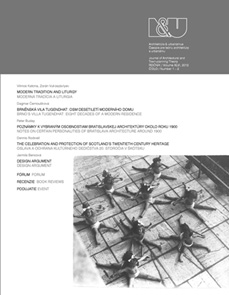POZNÁMKY K VYBRANÝM OSOBNOSTIAM BRATISLAVSKEJ ARCHITEKTÚRY OKOLO ROKU 1900, Franz Wimmer, Jenő Schiller, Gyula Schmidt, Jenő Soós
NOTES ON CERTAIN PERSONALITIES OF BRATISLAVA ARCHITECTURE AROUND 1900, Franz Wimmer, Jenő Schiller, Gyula Schmidt, Jenő Soós
Author(s): Peter BudaySubject(s): Cultural Essay, Political Essay, Societal Essay
Published by: Historický ústav SAV, v. v. i.
Keywords: architecture; work; project; builder; construction; plan; local; Budapest
Summary/Abstract: Bratislava, like other regional centres of the former Hungarian Kingdom, experienced extensive construction development at the end of the 19th century. As a result of its historical traditions, the town had a special status within the country. While the question remains open for future cultural and historical research as to whether efforts to build the ”western bastion” of the Hungarian Kingdom had a rogrammatic character, the crucial question here, in terms of the subject of our study, is how the given period inscribed itself on the architectural image of the town. In addition to the surviving examples of historicism and eclecticism, the “fin-de-siecle” period is also represented by works of early modernism, if mainly in terms of exterior experience, drawing inspiration from beyond the local context. Thanks to the openness of the local builders, Bratislava’s transferred their experiences from abroad to three-dimensional forms of highly rated objects, enriching the local, more conservative milieu with current and forward-looking moments. The content of the study focuses on the works of four architects created in the period before the outbreak of World War II. The text is based on the results of examination of historical sources: archival documents, periodicals and graphical materials. On this basis we tried to cast more light on the previously little-known activities of Franz Wimmer (1885 – 1953), Jenő (Eugene) Schiller (1878 – 1944?), Gyula (Július) Schmidt (1879 – 1915) and Jenő Soós (1853 – 1913). It must be admitted that the quantity, condition and especially the availability of documents does not allow for making more definite conclusions at the moment. However, the present text presents the total of the identified information, along with an indication of the future course of research, towards the end of extending our knowledge about Bratislava’s architecture around 1900. After years of neglect, the post-war work of Franz Wimmer created in cooperation with Andrej Szőnyi has become the subject of adequate professional attention. On the other hand, earlier reports on the architect´s work are reduced to stating solely his authorship of the Calvinist Church in Bratislava and the regulation of the square in front of the south facade of St. Martin´s Church. Despite his youth and relatively brief practice in Munich, Wimmer was perceived as an expert in Bratislava, which brought him several remarkable opportunities in his hometown even before 1914. As a student, he won the 2nd prize for a poster in competition issued by the Commission for Tourist Trade in Bratislava. (1908). The appearance of Wimmer´s poster is unknown, but assumptions can be made on the basis of published reviews. In 1909, Augustine Helmár revised earlier ideas about conversion of the area of former St. Martin´s cemetery into a regular square. With this in mind, he approached Wimmer. This step marks the genesis of Wimmer’s first architectural work in Bratislava, marked by ...
Journal: Architektúra & Urbanizmus
- Issue Year: 46/2012
- Issue No: 1-2
- Page Range: 52 - 71
- Page Count: 20
- Language: Slovak

